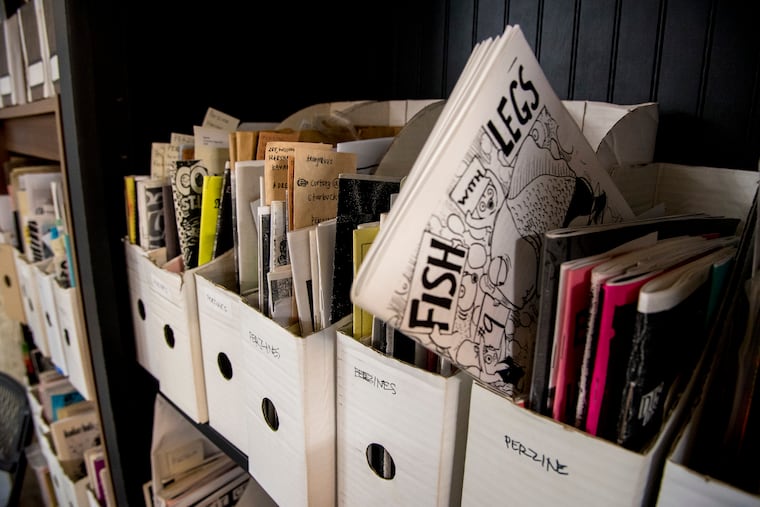In the digital age, zines of the ’90s are making an unlikely comeback
When the internet arrived on the scene, many predicted the end of the zine. They were wrong.

Katie Haegele describes herself as an accidental zine librarian.
It started in 2004: a trade here, a mail order there. Deadpan drawings. Animal-themed comics. A half-sheet booklet with mimeographed photos of fountain drinks called “I Love Soda.” By the time she and her husband stopped to count, they’d collected more than a thousand zines.
Now, she keeps them displayed on bookshelves and nestled in boxes, crowded in a room on the first floor of her home in East Falls.
Short for magazines or fanzines, zines are low-budget publications, usually homemade and self-published, often covering a niche topic or interest. They originated in the 1960s, when punk and DIY aesthetics produced a prolific underground publication subculture, and they reemerged in the 1990s, when the riotgrrl movement sparked their revival.
When the internet arrived, many predicted the end of zine culture.
Several decades later, it appears they were wrong.
Haegele calls her collection the East Falls Zine Reading Room. With more than 1,200 titles and a series of readings and performance events, it’s living proof of the zine’s staying power.
As a teenager in the ’90s, Haegele grew up familiar with zines. But she didn’t produce one herself until 2003, when found poetry and cut-and-paste styles led her back to the medium. That summer, she printed a stack and took them to the Philly Zine Fest. Begun in 2002, the fest was one of the first small-press fairs in the country. It was also Haegele’s first step into a world she didn’t know existed.
“I knew zines were a way to share your words and your art with the world,” she says. “I didn’t know it was an entire community.”
Before social media, instant messaging, and personal blogs, zines helped connect people across time and space based on shared interests or identities. Their accessibility empowered writers whose voices might otherwise go unrepresented in mainstream media — women, youth, people of color, and members of the LGBTQ+ community. Makers often listed their mailing addresses in the zines, meaning readers and writers could share everything from health tips to music suggestions. Exchange built intimacy, and intimacy built community.
For the last 15 years, Haegele has been producing and collecting zines, immersed in her own version of that community. She met her future husband, Joe Carlough, at a zine trade.
The founder of the Philly Zine Fest, Casey Grabowski, died in January after battling cancer. But longtime zine maker Dre Grigoropol says she sees the event, which features 70-plus exhibitors annually, continuing for years.
“Philadelphia is one of the centers of zine culture,” she says. “So much has started here.”
Over the years, new resources for zine makers and traders have cropped up in Philly. Take the Soapbox, a West Philly community print shop and library co-founded by Mary Tasillo and Charlene Kwon. Their collection started with two shoe boxes of zines. Seven years later, they’ve catalogued 2,500 titles and are still counting.
“Things just came out of the woodwork,” Tasillo says.
Zine readers and writers at the Soapbox span all ages — college students, mid-career artists, folks nearing retirement — and a variety of experience. “We’re really interested in making what we’re doing accessible,” Tasillo says.
She turns a brown paper booklet over in her hands. “I process a lot through making things ... zines are a reminder to not bellyache over every decision.”
In the digital age, many zine makers see accessibility and tangibility as keys to the format’s continuing appeal. Grigoropol frames them as a “retaliation towards web culture.”
Pablo Alarcón Jr., a senior at Temple University’s Tyler School of Art, disagrees. He thinks there’s a future for both digital and analog media in the zine world.
The zines he’s made combine both digital processing and traditional printmaking techniques; they’re accompanied by spoken-word poetry and found audio.
“Half my zine is on the internet and half needs to be held in your hand for the full experience,” he says. “One doesn’t feel complete without the other.”
Spaces like the EFZZR and the Soapbox inspire similar collections at places such as Kelly Writers House, a resource center at the University of Pennsylvania. For Miami transplant and KWH zine librarian Alyson del Pino, the collection has opened her eyes to the Philly zine community, which she describes as “passionate,” “funny," and “kind of grimy."
For del Pino, the zine format is inseparable from the community it fosters. “There’s something to be said for materiality,” she says. “When you read a zine, you get this raw glimpse into the life of the person who made it.”
Over the years, Haegele has watched new generations of students like del Pino rediscover the medium. It’s having a moment now, she says.
Then again, she adds, "zines never really went away.”